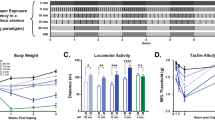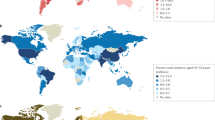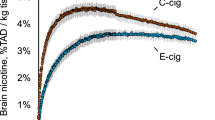Abstract
Studies suggest that reduced cognitive control due to nicotine withdrawal may have a critical role in promoting tobacco use. The P3 family of event-related brain potential (ERP) components is thought to serve as markers of cognitive control processes. Unfortunately, existing research that examines the effects of nicotine deprivation on P3 amplitude has been marred by small sample sizes and other design limitations. The present study sought to determine the effects of nicotine deprivation on P3b and P3a amplitudes, which index task relevant target detection and orienting responses to novelty, respectively. A secondary aim was to examine self-reported trait cognitive control as a moderator of nicotine deprivation-induced reductions in P3b and P3a amplitudes. In all, 121 nicotine-dependent smokers attended two experimental sessions following 12-h smoking/nicotine deprivation. In a counterbalanced manner, participants smoked nicotine cigarettes during one session and placebo cigarettes during the other session. Findings indicated that nicotine deprivation reduced P3b amplitude (p<0.00001) during a three-stimulus oddball task independent of trait cognitive control. In contrast, nicotine deprivation reduced P3a only among participants who scored lower on measures of trait cognitive control. Implications for conceptualizing risk for nicotine dependence, and its treatment, are discussed.
Similar content being viewed by others
Log in or create a free account to read this content
Gain free access to this article, as well as selected content from this journal and more on nature.com
or
References
Anokhin AP, Vedeniapin AB, Sirevaag EJ, Bauer LO, O'Connor SJ, Kuperman S et al (2000). The P300 brain potential is reduced in smokers. Psychopharmacology 149: 409.
Broadbent DE, Cooper PF, FitzGerald P, Parkes KR (1982). The Cognitive Failures Questionnaire (CFQ) and its correlates. Br J Clin Psychol 21: 1–16.
Claes L, Robinson MD, Muehlenkamp JJ, Vandereycken W (2010). Differentiating bionging/purging and restrictive eating disorder subtypes: the roles of temperament, effortful control, and cognitive control. Pers Individ Diff 48: 166–170.
Dien J (2010). Evaluating two-step PCA of ERP data with Geomin, Infomax, Oblimin, Promax, and Varimax rotations. Psychophysiology 47: 170–183.
Dien J, Spencer KM, Donchin E (2004). Parsing the late positive complex: mental chronometry and the ERP components that inhabit the neighborhood of the P300. Psychophysiology 41: 665–678.
Domino EF, Kishimoto T (2002). Tobacco smoking increases gating of irrelevant and enhances attention to relevant tones. Nicotine Tob Res 4: 71–78.
Evans DE, Drobes DJ (2009). Nicotine self-medication of cognitive-attentional processing. Addict Biol 14: 32–42.
Evans DE, Park JY, Maxfield N, Drobes DJ (2009). Neurocognitive variation in smoking behavior and withdrawal: genetic and affective moderators. Genes Brain Behav 8: 86–96.
Evans DE, Rothbart M K (2007). Development of a model for adult temperament. J Res Pers 41: 868–888.
Evans DE, Rothbart MK (2009). A two-factor model of temperament. Pers Individ Dif 47: 565–570.
First MB, Spitzer RL, Gibbon M, Williams JBW (1994). Structured clinical interview for axis I DSM-IV disorders—patient edition (SCID-I/P, version 2.0). Biometrics Research, New York State Psychiatric Institute.
Glass K, Frishkoff GA, Frank RM, Davey C, Dien J, Maloney AD et al (2004). A framework for evaluating ICA methods of artifact removal from multichannel EEG. Lect Notes Comput Sci 3195: 1033–1040.
Hagen GF, Gatherwright JR, Lopez BA, Polich J (2006). P3a from visual stimuli: Task difficulty effects. Int J Psychophysiol 59: 8–14.
Heatherton TF, Kozlowski LT, Frecker RC, Fagerstrom K-O (1991). The Fagerstrom Test for Nicotine Dependence: a revision of the Fagerstrom Tolerance Questionnaire. Br J Addict 86: 1119–1127.
Hendricks P, Ditre J, Drobes D, Brandon T (2006). The early time course of smoking withdrawal effects. Psychopharmacology 187: 385–396.
Houlihan M, Pritchard W, Robinson J (1996). Faster P300 latency after smoking in visual but not auditory oddball tasks. Psychopharmacology 123: 231–238.
Iacono WG, Carlson SR, Malone SM, McGue M (2002). P3 event-related potential amplitude and the risk for disinhibitory disorders in adolescent boys. Arch Gen Psychiatry 59: 750–757.
Iacono WG, Carlson SR, Taylor J, Elkins IJ, McGue M (1999). Behavioral disinhibition and the development of substance-use disorders: findings from the Minnesota Twin Family Study. Dev Psychopathol 11: 869–900.
Iacono WG, Malone SM, McGue M (2003). Substance use disorders, externalizing psychopathology, and P300 event-related potential amplitude. Int J Psychophysiol 48: 147–178.
Iwanami A, Kuroki N, Iritani S, Isono H, Okajima Y, Kamijima K (1998). P3a of event-related potential in chronic methamphetamine dependence. J Nerv Ment Dis 186: 746–751.
Knott V, Kerr C, Hooper C, Lusk-Mikkelson S (1995). Cigarette smoking and event-related brain electrical potential (ERP) topographies associated with attentional-distractive processes. In: Domino EF (ed), Brain Imaging of Nicotine and Tobacco Smoking 1st edn. NPP Books: Ann Arbor, MI. pp 191–221.
Lin W-L, Hsu K-Y, Chen H-C, Chang W-Y (2013). Different attentional traits, different creativities. Think Skills Creativity 9: 96–106.
Matthews G, Zeidner M (2012). Individual differences in attentional networks: Trait and state correlates of the ANT. Pers Individ Diff 53: 574–579.
Mobascher A, Brinkmeyer J, Warbrick T, Wels C, Wagner M, Grűnder G et al (2010). The P300 event-related potential and smoking — a population-based case-control study. Int J Psychophysiol 77: 166–175.
Newhouse P, Singh A, Potter A (2004). Nicotine and nicotinic receptor involvement in neuropsychiatric disorders. Curr Top Med Chem 4: 267–282.
Nunez PL, Srinivasan R (2006) Electric fields of the brain: the neurophysics of EEG/Paul L. Nunez, Ramesh Srinivasan 2nd edn. Oxford University Press: Oxford; New York, 2006.
Perkins KA, Karelitz JL, Conklin CA, Sayette MA, Giedgowd GE (2010). Acute negative affect relief from smoking depends on the affect situation and measure but not on nicotine. Biol Psychiatry 67: 707–714.
Polich J (2007). Updating P300: an integrative theory of P3a and P3b. Clin Neurophysiol 118: 2128–2148.
Polich J, Criado JR (2006). Neuropsychology and neuropharmacology of P3a and P3b. Int J Psychophysiol 60: 172–185.
Preisendorfer RW, Mobley CD (1988) Principal Component Analysis in Meteorology and Oceanographyby Rudolph W. Preisendorfer; Posthumously Compiled and Edited by Curtis D. Mobley 1st edn. Elsevier; Distributors for the US and Canada; Elsevier Science Pub. Co: Amsterdam; New York, NY, USA, 1988.
Saucier G (2002). Orthogonal markers for orthogonal factors: the case of the big five. J Res Pers 36: 1–31.
Schwebel DC, Stavrinos D, Kongable EM (2009). Attentional control, high intensity pleasure, and risky pedestrian behavior in college students. Accid Anal Prev 41: 658–661.
Singh A, Potter A, Newhouse P (2004). Nicotinic acetylcholine receptor system and neuropsychiatric disorders. IDrugs 7: 1096–1103.
Smilek D, Carriere JSA, Cheyne A (2010). Failures of sustained attention in life, lab, and brain: ecological validity of the SART. Neuropsychologia 48: 2564–2570.
Stern Y (2009). Reviews and perspectives: cognitive reserve. Neuropsychologia 47: 2015–2028.
Welsch SK, Smith SS, Wetter DW, Jorenby DE, Fiore MC, Baker TB (1999). Development and validation of the Wisconsin Smoking Withdrawal Scale. Exp Clin Psychopharmacol 7: 354–361.
Acknowledgements
This study was funded by NIH grants R21 DA027001 and R21 DA024226. We would like to thank Renee Ornduff and Natasha Garcia for their work on the project.
Author information
Authors and Affiliations
Corresponding author
Rights and permissions
About this article
Cite this article
Evans, D., Maxfield, N., Van Rensburg, K. et al. Nicotine Deprivation Influences P300 Markers of Cognitive Control. Neuropsychopharmacol 38, 2525–2531 (2013). https://doi.org/10.1038/npp.2013.159
Received:
Revised:
Accepted:
Published:
Issue date:
DOI: https://doi.org/10.1038/npp.2013.159
Keywords
This article is cited by
-
APOE genotype influences P3b amplitude and response to smoking abstinence in young adults
Psychopharmacology (2021)
-
Associations between Electrophysiological Evidence of Reward and Punishment-Based Learning and Psychotic Experiences and Social Anhedonia in At-Risk Groups
Neuropsychopharmacology (2017)
-
Nicotine-induced cortical activation among nonsmokers with moderation by trait cognitive control
Psychopharmacology (2016)
-
Cortical activity differs during nicotine deprivation versus satiation in heavy smokers
Psychopharmacology (2015)



